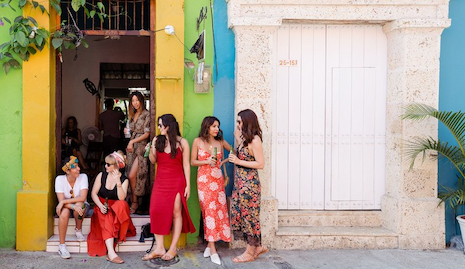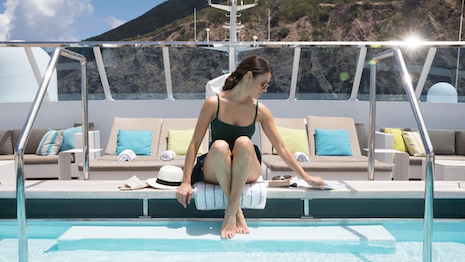 Community enhances travel experiences for women. Image credit: Condé Nast Traveler
Community enhances travel experiences for women. Image credit: Condé Nast Traveler
NEW YORK – As female consumers become more prominent in the travel and hospitality industry, luxury brands must create a sense of community and safety to help empower them.
Speaking on a panel at Condé Nast Traveler’s Points of View Summit, journalists and executives shared their personal experiences as professional women in travel. In particular, solo travel is on the rise among women of all ages, changing what travelers may require from brands.
“It’s very empowering for women to travel alone,” said Sharon Flax-Brutus, director of the British Virgin Islands Tourist Board and Film Commission. “Years ago, you had to travel with your husband or family.
“No one expected women to experience life or experience travel on their terms,” she said.
Independent communities
It is a relatively new concept for women, even affluents, to have the purchasing power to enjoy leisure travel independently or with other women. As the panelists noted, it was only a few decades ago that women were legally prohibited from obtaining credit cards without having a male cosigner.
Perhaps as a result, this is why solo travel is popular among women from millennials to boomers. Journalist Jada Yuan shared that while she was The New York Times’ inaugural “52 Places Traveler” she met many women in their sixties traveling alone for the first time, whether their travels were happening after a divorce, retirement or another major life event.
Women in Travel panel. Image credit: Condé Nast Traveler
However, a more common perception of an independent traveler is that of a millennial. Younger generations have a tendency to place more value on experiences rather than material goods.
“The millennial traveler is looking at life a little bit differently – we’re not waiting until retirement to have these experiences,” said Evita Robinson, founder of Nomadness Travel Tribe. “We’re going out at a younger age, maybe even before having families.”
Ms. Robinson founded her travel lifestyle brand as a way to connect millennial travelers, particularly those of diverse backgrounds, with each other. Nomadness has since curated nearly 30 international group trips.
“I wanted to see like-minded travelers that looked like me, had the same background, but also had travel as a focal point and priority in their lives,” Ms. Robinson said. “For me it was very integral for me to find that community – community is at the guts of all of this.”
Established hospitality brands have also been responding to travelers’ desire for community.
For instance, Crystal Cruises hosts special events during every voyage that are designed to bring together passengers who are traveling independently.
“It doesn’t matter where you are in life,” said Carmen Roig, senior vice president of marketing and sales at Crystal Cruises. “Travel is about enriching experiences and sharing them with people who have the same types of interests that you do.”
Even when traveling alone, some women turn to social media or planned excursions to connect with others. Image credit: Crystal Cruises
Social media is another way that women connect with each other and build community. According to a survey from Allianz Global Assistance, about half of millennials say social media influences their travel decisions (see story).
Condé Nast Traveler has expanded its own Women Who Travel initiative from a Facebook group to a podcast series and now offers readers the opportunity to experience curated group trips. The publication has also established a Women Who Travel Advisory Board, whose members include Ms. Robinson and Ms. Roig among others, as well as World Cup Champion Megan Rapinoe and Pulitzer Prize-winning photographer Lynsey Addario.
Global perspectives
Independent travel is not just a Western phenomenon and is becoming more popular among Chinese consumers.
Six out of 10 independent travelers from China are women, and this accounts for more than 58 percent of bookings made on the travel aggregator Ctrip. Cities where most of these female solo travelers come from include Beijing, Shanghai, Shenzhen, Guangzhou, Chengdu, Chongqing, Xi’an, Wuhan, Tianjin and Xiamen (see story).
In the past, Chinese travelers have been known for traveling in large tour groups, but more independent travel is coming into favor, especially among millennials. One in 10 Chinese millennials will travel solo, although most Chinese prefer traveling with family members or close friends according to research from Resonance (see story).
Whether traveling independently or in groups, however, safety remains an important consideration for female travelers. For women of color, safety can be more paramount due to attitudes in more conservative cultures, Ms. Robinson explained.
Even in upscale destinations, dangerous situations can arise quickly.
Some of Hong Kong’s violent clashes have taken place in tourist districts, including in Tsim Sha Tsui where the Peninsula Hotel and InterContinental are located. The proximity of these events, as well as the duration and scale of the protests, has raised concerns for travelers (see story).
“We need to be more forthcoming in terms of communication with the traveler community,” Ms. Flax-Brutus said. “What’s happening in our destination? How are we helping the traveler feel safer? How can we make that experience of a solo traveler be a very personal experience?”

